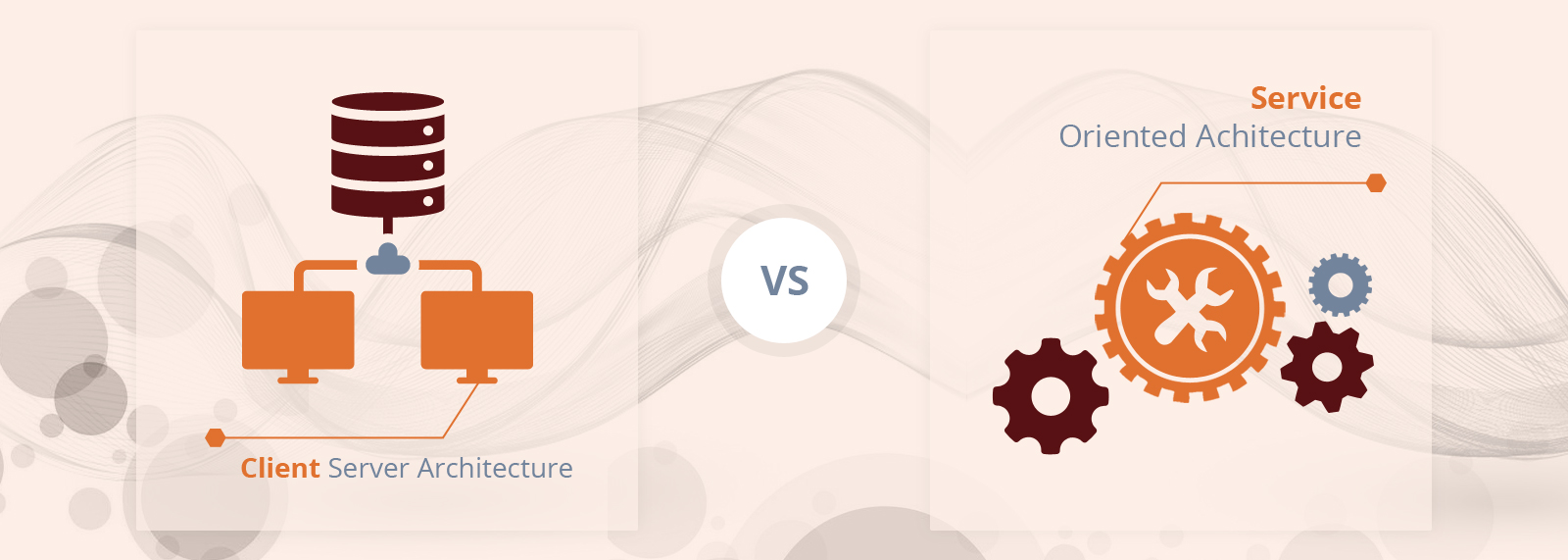What is client-server architecture?
Client-server architecture is a computer-network where clients appeal and accept services from a centralized server also known as host computer. You are given an interface that enables computer users to appeal for services of the server and also showcase the results server yields. Here, servers do wait for clients’ requests and respond to them accordingly. Ideally, client-server architecture does provide a standardized and transparent interface for the clients, hence the client do not require being aware of system specifics, i.e. software and hardware. Clients are often placed at the workstations or working from their personal computers, while the server is placed away, somewhere on the network, generally on a more potent machine. This architecture is in effect when server and clients each has different jobs that they customarily perform.
What is server-oriented architecture?
Let’s start with a simple definition – This architecture is the slant where network components are arrayed as per the services offered. In service-oriented architecture, services are demarcated as individual program that creates building blocks, allowing the users to influence information and data in their very own way, effortlessly. The service serves as a channel through which users’ requirements are addressed. It is provided through a negotiated contract by a communication protocol. Services of server-oriented architecture are usually self-determining technologies, products or vendors. Therefore, organizations offering ASP.NET development services can avail the infrastructure service across different and independent networks.
Client-server architecture: Use and Benefits
Businesses often look for opportunities in order to upkeep their services and also a healthy competition to sustain in the industry niche using latest technologies. Deploying client-server computing in your business sure will improve the productivity as the architecture has cost-effective interface, reliable application services, wide connectivity and enhanced data storage. Below are the benefits of deploying client-server architecture in your organization in pointers –
Improved data sharing
You can easily retain all your business data through usual dealing processes and manipulate them on a server, which is available only for titled clients over an accredited access.
Integration of services
Each client gets the opportunity to avail corporate data via desktop interface exterminating the requirement to sign-up with a processor or terminal.
Shared resources amongst multiple platforms
Application castoff for client-server computing model is designed regardless of technical background of the authorized software (which is providing an open computing environment) or the hardware platform. It moreover enforces the users to acquire clients’ as well as servers’ services.
Data processing capability despite location
In this architecture, users are logged into the system regardless of any location, distance or the processor technology.
Easy maintenance
It’s an absolute shared model, representing dispersed liabilities amongst autonomous computers integrated over a network. Thus, it is easy to repair, replace, relocate a server and upgrade while clients remain unmoved.
Security
Servers do have improved resources and controlled access to ensure that only designated clients are allowed the access to manipulate the data. Here, all server updates are as well managed ensuring highest efficacy.
Server-oriented architecture – Use and benefits
Service: Users experience improved data flow, ability to demonstrate internal functionality and there is of course an organizational flexibility.
Service re-use: Cost-effective management and software development.
Messaging: Users enjoy absolute configuration flexibility.
Message monitoring: There are business intelligence, performance measurement and security attack detection.
Message control: Perhaps two of the most desired benefits: application of management policy and application of security policy.
Message transformation: Data translation has always been a concern in the niche of software/application development, but by deploying server-oriented architecture, you can truly enjoy the same.
Message security: The most desired and most essential feature: data integrity and data confidentiality.
Complex event processing: here the users enjoy simplification of software structure, ability to adapt faster to other external environments and better manageability and security.
Service composition: Users are allowed to develop new function combinations at individually required pace.
Service discovery: Users are given opportunity to optimize performance, cost and functionality. Moreover, it gives a simpler introduction of system upgrades.
Asset wrapping: Users can integrate existing assets into the system.
Virtualization: There is an improved reliability and users are able to scale operations as they meet multiple demand levels.
Model-driven implementation: Users can develop new functions as quickly as they require.
SOA Vs Client-server architecture: In A Nutshell
Application logic: While the client-server architecture has fat client, working through data-related logic and bulk of processing; in the matter of SOA, choices are about where the application logic can possibly live and how it gets shared.
Application processing: While the client-server architecture trails 80/20 wherein processing is done in bulk, SOA allows a unequivocal functional margin and resource condition.
Technology: While client-server architecture makes the most of 4GL programming languages and 3GL programming languages for performance causes, SOA uses XML data representation arch coupled with SOAP message framework. Server-oriented architecture basically uses CSS, HTTP, HTML etc.
Security: While client-server architecture is centralized on the server side, SOA is heavily dependent on WS-security framework for security purpose.
Administration: While client-server architecture’s maintenance cost is higher, SOA is immune to user-side maintenance needs.
Why choose Flexsin
Flexsin’s Client-Server Architecture and SOA suite offers all-inclusive modules for developing, securing and monitoring the both. Our service modules include business rule, human task, mediator and spring. These help build blocks that can be used for the construction of SOA/client-server architecture based applications.


 Parimal
Parimal


